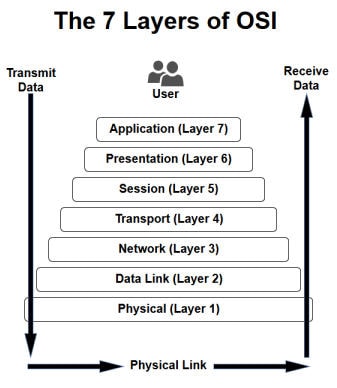
The OSI model is a framework that defines how different types of digital equipment communicate across a network. This model is divided into seven layers, each one being independent of the other.
The OSI Reference Model, OSI being an acronym for Open Systems Interconnection is a stack of hierarchical communication protocols very often used to build a computer network. OSI is a standard of the International Standardization Organization, issued in 1984.
The OSI model divides the complex communication dilemma between two or more systems into seven layers in a hierarchical architecture.
Each layer has distinct functions and communicates only with the adjacent layers.
The OSI standard has seven layers:
1. Physical
2. Data Link
3. Network
4. Transport
5. Session
6. Presentation
7. Application
Although other systems are currently being used today, most communication equipment manufacturers use OSI to instruct users on how to use the equipment and OSI is widely considered the best way to understand how information is being sent and received over a network.
Some of the benefits of using OSI:
1. Breaks up the network communication phenomenon into smaller parts that are implicitly simpler.
2. Standardize the components of a network allowing independent development that is not tied up to a particular manufacturer.
3. Provides communication between different hardware parts and software.
4. Provides a more natural understanding of the communication phenomenon.
Each layer defines how things should happen in the network and on the Internet. All layers have protocols that describe the behavior of network devices.
For example, when we want to send traffic to a particular server, we’ll use a protocol called IP, that uniquely identifies devices on a network or the Internet. Or, if we want to download a file or access a web page, then we will use protocols such as FTP and HTTP.
The basis for establishing the architectural layers of the ISO OSI model has been a set of general principles, such as:
1. creating a small number of layers with few interactions between them;
2. gathering related functions on the same layer;
3. creating the possibility of changing the features of a layer without affecting the others;
4. Creating boundary lines for each layer between the former and the next layer.
Application Layer
Realizes the connection between the user interface and the application interface, specifies to the user the working interface and manages communication between applications.
Presentation Layer
Transforms the data into formats understood by all applications and the respective computers, manages data compression and encryption.
Session Layer
It provides control over the communication between applications. Establishes, maintains, manages and closes connections between applications.
Transport Layer
It ensures the reliable transfer of information between the two endpoints of a digital exchange of data. Provides error control and data flow control between two endpoints, ensuring the correct order of data packets. Offers a data transport service that isolates the higher layers of any particularities related to the way the transported data is executed.
Network Layer
It determines the optimal way to achieve the transfer of information across a multi-segment network by fragmenting and reassembling information.
Data Link Layer
The data link layer deals with the physical address, network topology, network access, error detection and reporting, and flow control.
Provides secure, reliable data transport along a physical link, realizing:
1.Communication error control
2. Data flow control
3.Control the link
4.Synchronization at the frame level
Physical Level
Physical level defines electrical, mechanical, procedural and functional specifications for activating, maintaining and deactivating physical connections between systems.
Transmitting a group of bits on a communications channel. Modulations, encodings, bit-level sync are specified. A physical-level standard defines four types of features:
1. Mechanical
2. Electrical
3. Functions
4. Procedures

